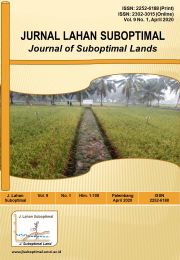Landuse Planning for Food Crop Areas Development Using Land Resource Evaluation Approach and GIS Application (a Case Study of Pulang Pisau District, Central Kalimantan Province)
DOI:
https://doi.org/10.33230/JLSO.9.1.2020.471Keywords:
land allocation, arable lands, data, management, Pulang Pisau districtAbstract
Agustini S, Suparman S, Tridamayanti HC. 2020. Landuse planning for food crop areas development using land resource evaluation approach and gis application (a case study of Pulang Pisau District, Central Kalimantan Province). Jurnal Lahan Suboptimal: Journal of Suboptimal Lands 9(1): 64-72.
In order to promote sustainable landuse, the need of landuse planning is urgently required and it can be designed based on the result of spatial land resource data management. Land resource evaluation is main component for landuse planning which this procedure was applied to determine land allocation for arable lands for rice farming development. The use of geographic information system (GIS) technology was also employed not only for spatial data management, but they could also be applied to support decision making within establishing landuse planning. The objective of this study was to allocate the arable lands for extensification and intensification regions as main part of landuse planning for food crops areas development. In the case of Pulang Pisau District, land allocation for extensification and intensification regions were mainly found in southern part and mostly located at watershed areas with each total areas respectively of 380,261 hectares (36.81%) and 29,941 hectares (2.90% of total areas of Pulang Pisau District). In order to support these potential areas, specific programs could then be formulated to increase the yield and productivity for these regions.
Downloads
Published
How to Cite
Issue
Section
License
Copyright (c) 2020 Sri Agustini, Suparman Suparman, Hia Cinta Tridamayanti

This work is licensed under a Creative Commons Attribution-NonCommercial-ShareAlike 4.0 International License.













